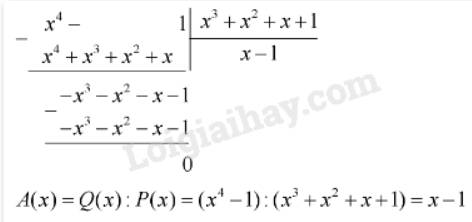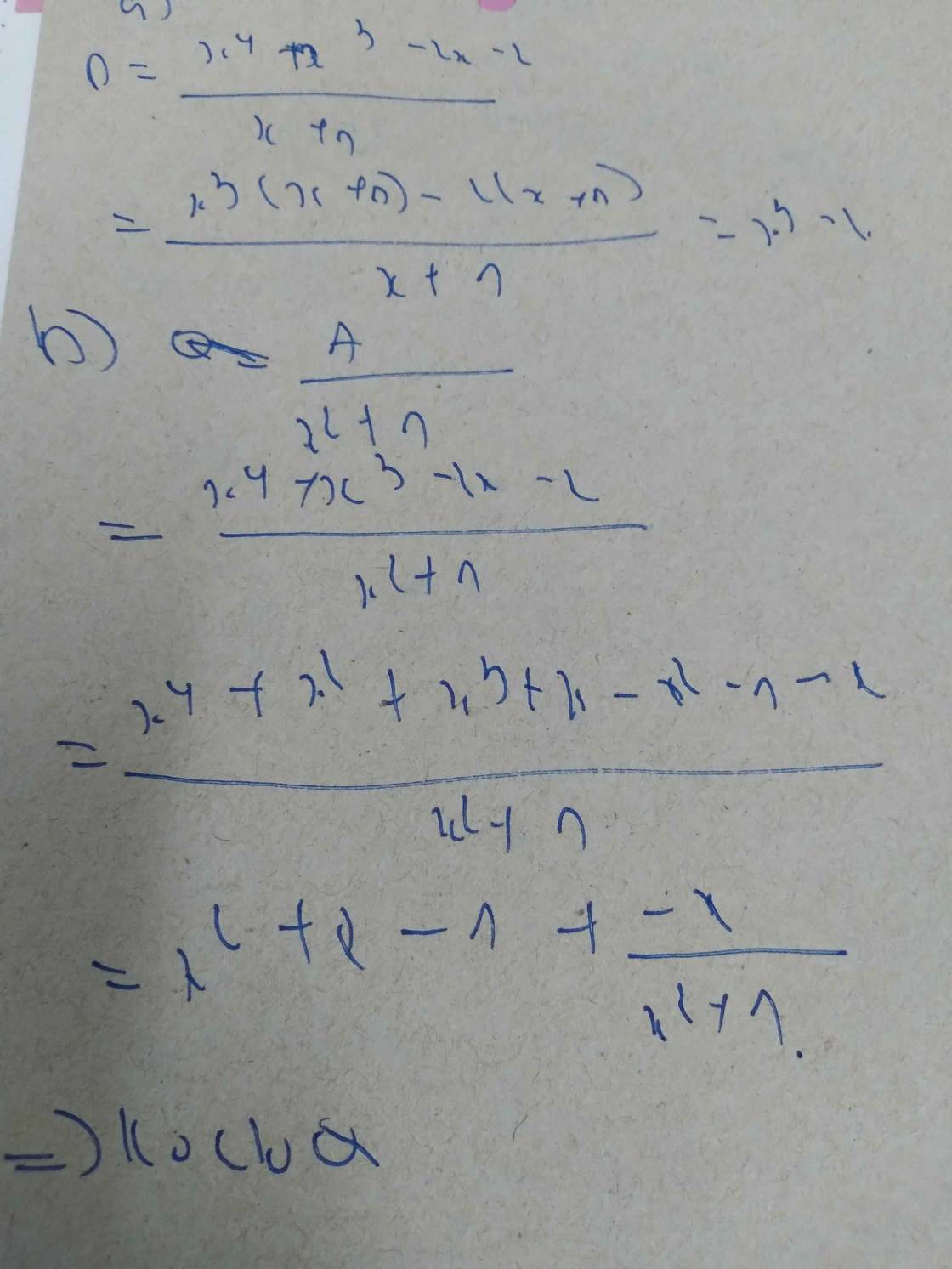
Hãy nhập câu hỏi của bạn vào đây, nếu là tài khoản VIP, bạn sẽ được ưu tiên trả lời.


\(P(x).A(x) = Q(x) \Rightarrow A(x) = Q(x):P(x)\)

Vậy \(A(x) = x - 1\).

1/a, f(x) - g(x) + h(x) = x3 - 2x2 + 3x +1 - x3 - x + 1 +2x2 - 1
=(x3 - x3) + (-2x2 + 2x2) + (3x - x) + (1 + 1 - 1)
=2x + 1
b, f(x) - g(x) + h(x) = 0
<=> 2x + 1 = 0
<=> 2x = -1
<=> x = -1/2
Vậy x = -1/2 là nghiệm của đa thức f(x) - g(x) + h(x)
2/ a, 5x + 3(3x + 7)-35 = 0
<=> 5x + 9x + 21 - 35 = 0
<=> 14x - 14 = 0
<=> 14(x - 1) = 0
<=> x-1 = 0
<=> x = 1
Vậy 1 là nghiệm của đa thức 5x + 3(3x + 7) -35
b, x2 + 8x - (x2 + 7x +8) -9 =0
<=> x2 + 8x - x2 - 7x - 8 - 9 =0
<=> (x2 - x2) + (8x - 7x) + (-8 -9)
<=> x - 17 = 0
<=> x =17
Vậy 17 là nghiệm của đa thức x2 + 8x -(x2 + 7x +8) -9
3/ f(x) = g (x) <=> x3 +4x2 - 3x + 2 = x2(x + 4) + x -5
<=> x3 +4x2 - 3x + 2 = x3 + 4x2 + x - 5
<=> -3x + 2 = x - 5
<=> -3x = x - 5 - 2
<=> -3x = x - 7
<=>2x = 7
<=> x = 7/2
Vậy f(x) = g(x) <=> x = 7/2
4/ có k(-2) = m(-2)2 - 2(-2) +4 = 0
=> 4m + 4 + 4 = 0
=> 4m + 8 = 0
=> 4m = -8
=> m = -2

a)\(\frac{x+2}{x+5}< \frac{x+1}{x+4}\)
\(\Leftrightarrow\frac{x+5-3}{x+5}< \frac{x+4-3}{x+4}\)
\(\Leftrightarrow1-\frac{3}{x+5}< 1-\frac{3}{x+4}\)
\(\Leftrightarrow\frac{3}{x+5}>\frac{3}{x+4}\)
\(\Leftrightarrow x+5< x+4\)
Vì \(x+5\)luôn lớn hơn x+4 với mọi x
nên không có giá trị x thỏa mãn
b) \(\frac{x-1}{x-2}< \frac{x+4}{x+3}\)
\(\Leftrightarrow\frac{x-2+1}{x-2}< \frac{x+3+1}{x+3}\)
\(\Leftrightarrow1+\frac{1}{x-2}< 1+\frac{1}{x+3}\)
\(\Leftrightarrow\frac{1}{x-2}< \frac{1}{x+3}\)
\(\Leftrightarrow x-2>x+3\)
Vì \(x+3>x-2\)với mọi x
nên không có giá trị x thỏa mãn

a: Q(x)=3x^4+x^3+2x^2+x+1-2x^4+x^2-x+2
=x^4+x^2+3x^2+3
b: H(x)=2x^4-x^2+x-2-x^4+x^3-x^2+2
=x^4+x^3-2x^2+x
c: R(x)=2x^3+x^2+1+2x^4-x^2+x-2
=2x^4+2x^3+x-1

Ta có: A=(x-4)-3(x+1)
=x-4-3x-3
=-2x-7=4
=>-2x=11 => x=-11/2
Vậy x=-11/2
\(A=\left(x-4\right)-3.\left(x+1\right)\)
\(\Rightarrow A=x-4-3x+3\)
\(\Rightarrow A=-2x-1\)
Mà A = 4
=> 4 = -2x - 1
=> 2x = -5
=> x = \(-\frac{5}{2}\)